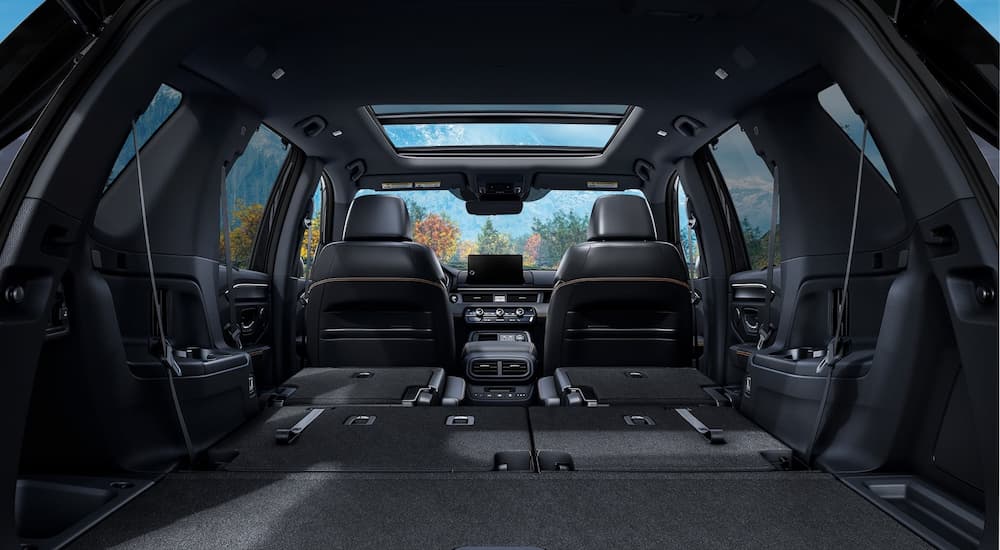Honda has staked out its place among the leaders in the SUV market. A big part of this success can be attributed to the Honda Pilot, the brand’s entry into the three-row SUV segment. For 2023, you can find an all-new version of the Pilot at your local Honda dealer. This is a more rugged model with improved performance, something we have seen with each of the previous three generations. In fact, Honda has made significant and major changes with each generation it has produced over the years. Each seemed designed to capture the desires of drivers looking for a midsize SUV that is dependable, reliable, safe, and affordable, with an appearance that was just right for the time.
The story of the Pilot started 20 years ago when Honda decided it was time to boldly enter the midsize SUV market with an in-house design to replace the rebadged Isuzu Rodeo that had been sold as the Honda Passport. The Pilot was geared to compete with similar models from other brands but with an eye toward giving drivers better value in their vehicles. This has remained the case with each successive update and upgrade of the model.
2003: The Pilot Launches
Unlike many other midsize SUVs that began life as two-row models, Honda launched the Pilot right out of the gate as a three-row SUV. This was crucial since it meant that the designers were thinking about maximizing space for up to eight passengers right out of the box. While other automakers with legacy midsize SUVs had to scramble to retrofit a third row into their vehicles, the designers at Honda were always thinking about three rows on the Pilot. Even the first model from 2003 had ample room for eight passengers while providing 16.3 cu.ft. of trunk space behind the third row of seats.
Honda also started a trend that would continue with the first Pilot, giving it a standard 3.5-liter V6 engine paired with a five-speed automatic transmission. This engine utilized Honda’s legendary VTEC variable valve timing technology to provide efficient performance, with an output of 240 hp and 242 lb-ft of torque. All-wheel drive was standard for the first few years of the Honda Pilot.
The Pilot also stood out from the pack by utilizing a unibody design based on Honda’s popular Odyssey minivan. Most other midsize SUVs of the time had a body-on-frame design, usually using a midsize truck as the basis. This made the 2003 Pilot easier to handle than most other midsize SUVs and gave it better overall fuel economy and a safer and sturdier design. However, the exterior still had the boxy look that was in style at the time, with plenty of glass to let the light in and give your kids a good look outside.
In 2006, Honda started a trend that it would continue with the Pilot. The 2006 Pilot received a makeover, utilizing the same general design of the first-generation model but with an updated grille to provide improved engine airflow and new front and rear fascias. This made the first generation slightly more aerodynamic. Honda also began to offer the Pilot with front-wheel drive on the base trims to give drivers the option of even better fuel economy.
2009: I’ll Second That Emotion
Whoever said “the bigger, the better” probably had the second-generation Honda Pilot in mind. Honda increased the wheelbase, which yielded more legroom in the third row and more trunk space. It also gave the Pilot bulkier exterior styling than it had in the first generation. This is why it is easy to tell the first-generation and second-generation models of the Pilot apart.
The 2009 Pilot also gave drivers a more powerful engine. Basically, Honda took the standard 3.5-liter V6 gas engine on the Pilot and gave it a serious boost. This resulted in 250 hp and 253 lb-ft of torque, giving the Pilot better overall acceleration. However, an updated Variable Cylinder Management system meant that the more powerful engine was actually more efficient. The five-speed automatic transmission continued from the prior generation, as did the choice of front-wheel or all-wheel drive that began with the 2006 Pilot model.
Honda also gave more attention to comfort and convenience features with the second-generation Pilot. For example, the 2009 model came with a standard seven-speaker audio system. The 2012 update of the Pilot added Bluetooth connectivity to many of the available trims. This would eventually become a standard feature in the Pilot. This mid-generation update continued Honda’s tradition of an update every three years on the Pilot. The 2012 Pilot also received a more aerodynamic front fascia, which was signaling the direction Honda would take with the third-generation model.
2016: Third Times a Charm
When it comes to radical redesigns, few models can compete with the 2016 Honda Pilot. This was a major departure from the prior generation, with the third generation jettisoning the boxy design for a streamlined look that was similar to the compact Honda CR-V. It also increased the wheelbase again, giving an increasing amount of room for the trunk and passenger cabin.
The streamlined appearance of the third-generation Pilot gave it better fuel economy. This helped offset the boost given to the standard 3.5-liter V6 gas engine. The improvement yielded an impressive 280 hp and 262 lb-ft of torque. The transmission was also changed, with most trims getting a six-speed automatic transmission, while the Touring and Elite trims were equipped with a nine-speed automatic.
Honda also increased the technology available in the Pilot, giving drivers improvements in safety and convenience features. The 2016 Pilot features Honda Sensing driver-assistance technology on all trims except the LX, which would eventually get it in time for the 2019 model year. Honda also gave the Pilot a standard infotainment system with Bluetooth, which would come to include Apple CarPlay and Android Auto connectivity during the course of the third generation. The size of the touchscreen would also grow from five inches on the lower trims all the way to a standard eight inches by the time of the 2022 model.
While Honda made a number of incremental improvements to the mid-generation 2019 Pilot model, probably the biggest change in the third generation happened in 2022. This came with the introduction of the Pilot TrailSport, an adventurous off-road trim with boosted ground clearance, specialized tires, and added protection around the wheel wells. It also signaled what was to come with the fourth-generation Pilot in 2023.
2023: The Fourth Dimension of Pilot
The new generation of the Pilot roars in with a look that is unlike any of the three generations that came before. It is easily the largest Pilot Honda has ever built and looks more rugged than ever, building on the TrailSport model introduced in 2022. In fact, the new Honda Pilot adds 3.4 inches of length over the third-generation model. This translates to even more passenger and cargo space on one of the roomiest models in its segment. The 2023 Honda Pilot is a true three-row SUV that can actually seat up to eight passengers very comfortably.
The 2023 Pilot runs on a 3.5-liter V6 gas engine paired with a 10-speed automatic transmission and can produce 285 hp and 262 lb-ft of torque. This is the most horsepower from any Pilot engine to date. Drivers can choose between front-wheel drive and the second generation of Honda’s i-VTM4 torque vectoring all-wheel drive system. This delivers the right amount of torque to each of the Pilot’s wheels, giving you exceptional traction. Honda has also equipped every 2023 Pilot trim with standard hill descent control, a first for this model.
Four Generations to Pilot You Into the Future
To know the future, you must sometimes look back into the past. With 20 years of amazing vehicles, the Honda Pilot has staked out its place as one of the most durable three-row midsize SUVs. Honda has also demonstrated how making incremental changes over time, paired with a radical remodeling with each generation, will allow drivers to enjoy a version of the Honda Pilot that has the looks and capabilities to fit the time.






